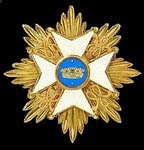This is one of my favourite French infantry flags of the 18th century. As Kronoskaf have only a partial history of the regiment in the Seven Years War, I have translated and present almost the whole of Susane's account in Volume 3 of the Histoire De L'Ancienne Infanterie Française as it includes some useful anecdotes and mention of casualties in various actions. Some of the account may need to be taken with a pinch of salt as it is clearly very pro-French! I have checked some of the place names mentioned in the text with Kronoskaf accounts but a few are still obscure - those I have marked with [sic?].
I have also produced two versions of the flags. Normally I give a 300 dpi version but here, as an experiment, I have also submitted a 600 dpi version as it seems to me that the detail is rather clearer. At the sizes at which these flags are likely to be printed and used by wargamers it may not matter but I would be interested to hear opinions about this. The first flags are the 300 and the second the 600.
And here is the second 600 dpi version:
Regimental origins: Descended from a Protestant unit raised in 1558, Navarre was one of the oldest regiments in the French army. It was a four battalion regiment.
Regimental history from Susane Vol.3 (my translation): In the spring of 1756 it was encamped near St Malo as part of a corps commanded by the Duc d'Aiguillon sent to Brittany to prevent a threatened attack by the British. Twenty four volunteers of the regiment under lieutenant of grenadiers St Étienne were in a boat which was approached by a British cutter, which had for some time annoyed local fishermen. Once the two boats were alongside each other the Navarre volunteers swarmed onto the cutter and captured it.
Having spent the winter at Morlaix and Saint Brieuc the regiment joined the army of Marshal d'Estrées in 1757. At the battle of Hastenbeck on the 26th July the Navarre brigade, under the orders of Chevert, was given the task of turning the enemy's left flank. The grenadiers especially distinguished themselves. Colonel Comte du Châtelet-Lomond (later to be the last colonel of the Gardes Francaises) was wounded at the beginning of the action with a gunshot wound to the lower abdomen. Captains d'Ablancourt and La Vie were killed, as was Lieutenant de Forteuil. Captains Dortez, Lefrus, Bortier, Cassabé, de Bonce, Coquabanne and six other officers were wounded. The regiment lost, in addition, eighty soldiers, almost all grenadiers. After the campaign the regiment took up winter quarters at Einbeck. After the allies violated the convention of Kloster-Zeven in December the regiment moved to the lower Weser but then returned to Einbeck.
In 1758 the army moved back to the Rhine and Navarre was stationed at Meurs. On the 23rd June at the battle of Krefeld it had little to do but did lose lieutenant La Jeannie. It was distinguished several days later at the "affair of Luynen" and in September the grenadiers fought valiantly at the surprise attack on the camp of the Prince of Holstein at Bork. Captains Saint Privé and d'Auboeuf were killed. Winter quarters were in Cologne.
On 1st August 1759 during the battle of Minden the regiment made an abortive attack on the village of Hille after which it had to make a very punishing retreat. But the grenadiers, under the command of Monsieur de Saint Victor, overcame all obstacles and allowed the regiment to rejoin the army without severe losses. In these diverse actions only two officers were wounded, Captains Morival and Desmarens. A sergeant named Lebrun saved the staff records and for his bravery was made an officer. Winter quarters were at Aschaffenburg.
In 1760 the regiment joined the army at Grumberg and provided detachments for the sieges of Marburg and Dillenburg. At the battle of Korbach the regiment was ordered by Marshal de Broglie to attack the heights on the left of the position held by the Hereditary Prince of Hesse and defended by 16 guns. Approach was made under the cover of woods but the attack was repelled by blasts of grape shot. Then the grenadiers and chasseurs, combined under the command of Monsieur de Saint Victor, charged again with great vivacity and, giving the gunners no time to reload their guns, forced them to flee. Sixteen year old cadet Monsieur de Kergru was the first into the position and killed with his bayonet a gunner who was about to fire his gun.
On the 31st of August Navarre fought at Warburg. The volunteers distinguished themselves on several occasions under the leadership of Monsieur de Brécourt and de Sion; the latter was killed. At the end of the campaign the regiment contributed 200 men for the garrison of Gottingen and went into winter quarters at Kassel. The reunited grenadiers and chasseurs were stationed on the Weser. On the 22nd December they took Heiligenstadt and rendered the place indefensible.
In January 1761 lucky coups de main made them masters of Duderstadt and Stattworbes [Stadtberg?]. The day after the taking of the latter town the enemy, heavily reinforced, counter attacked. Two companies of chasseurs attacked them with the bayonet and drove them back. One of these companies lost ten men. However this detachment, too weak to hold all the captured places, was obliged to evacuate them and rallied the regiment at Kassel. Kassel was invested on the 15th February by the Count of Lippe at the head of an army of 20,000 men. During the night of the 6th to 7th of March a sortie was made. The 1st and 3rd battalions of Navarre were at the head of the left column of attack, which chased the enemy from two parallels and seized two batteries, one of howitzers and one of cannon. The howitzers were taken away; the cannons were spiked, their carriages broken, the batteries razed and the trenches filled in. Lieutenant Dassat with the vanguard reached even to the artillery depot and damaged it. The vanguard lost many people and above all many excellent NCOs. Captain de Soulanges and lieutenant of chasseurs Saint Loûet were killed in this sortie. On the 22nd a new sortie was made by the garrison; it cost the life of captain of grenadiers de Vertamont. In defence of the Warburg redoubt the regiment also lost Monsieur de La Touche. The enemy was obliged to raise the siege of Kassel and was harrassed in its retreat by the energetic garrison.
In July Navarre joined the army of Marshal de Broglie. It took no part in the battle of Vellinghausen but on the 3rd September helped in the taking of the castle of Sabbaborg [sic?]. After being involved in many expeditions of little significance the regiment took up winter quarters at Rothenburg and Homburg.
Navarre took part in the campaign of 1762 under Marshals d'Estrées and de Soubise. On the day of the action at Grebenstein, 4th June, Navarre was stationed at Immenhausen to protect the line of retreat. Captain Martincourt was wounded. Some time later, Navarre was ordered to conduct a convoy to Ziegenheim. It was necessary to go nine leagues in the rear of the enemy. The main object of the mission was a success but on the return journey it was attacked and only with skilful manoeuvres was it possible to escape a whole army bent on its destruction. After the capture of the castle of Amöneburg the regiment was then sent to the source of the Lohn [sic?] where it ended the campaign and the war. Lieutenant de Morlaincourt was the only officer of Navarre killed in 1762.
And this is the uniform plate from the 1757 MS:





















Very handsome standards!
ReplyDeleteBest Regards,
Stokes
Superb! I have three Irish regiments soon off the painting desk that will be sporting your fine flags. A couple of French battalions will be going into work soon.
ReplyDeleteTo be honest me ageing eyes can't tell the difference between the 300 and 600 dpi. When printed out for 28mm on a good printer, then the difference might be noticeable. Fascinating history of the unit too.
ReplyDeleteOh.. very tempted to upgrade the flags on my Navarre now!
ReplyDeletehttps://lh4.googleusercontent.com/proxy/Clr29h0Kn7SuMCZAranTTa9ijbVt6XxgDqjtyueTbpoGt2oVx_qJFOiutm5eOhMa4OtBrKYZzD9A79M20NeljWQBOlMo2O5C8A3IkRPnkyagSQOJkFQM50r2zSvSgRIIZtet5GiJbJCbXeXEoA=s0-d
Thanks, Stokes. :-) I do like the French 18th century flags; so much more interesting than the Napoleonic ones, I feel... (I do like some of the Revolutionary War flags, though; perhaps I'll get round to some of those eventually...)
ReplyDeleteAll good wishes,
David.
Thanks, Jonathan. Do please let me have pictures of your Irish regiments with my flags, when you can! Thanks.
ReplyDeleteWhat French units are you planning?
All good wishes,
David.
Thanks for commenting, Steve J.. I think you may well be right; it would be interesting to see the 2 sets of flags printed on a decent colour laser printer (which I don't have!). For most purposes it may well not be at all significant.
ReplyDeleteGlad you enjoyed the translation of Susane's account of Navarre.
All good wishes,
David.
Steve-the-Wargamer said...
ReplyDeleteOh.. very tempted to upgrade the flags on my Navarre now!
Go on, Steve. You know you really want to do it! ;-) If you do, please do let me see pictures of the flags in action. Thanks!
Thanks for the shot of your French troops; they look good. I would say this, wouldn't I?, but I think my flags would make them look even better. :-)
All good wishes,
David.
It took me a while - but I've only gone and finally done it! :o) https://steve-the-wargamer.blogspot.com/2024/12/firing-into-brown-70-navarre-reflagged.html
DeleteThe flag of the Navarre Regiment is one of my favourites. It's a pitty, that the uniform of this Regiment is looking so dull.
ReplyDeleteOne unit more to reflag...
Thanks, André. Yes, it's a good one, isn't it? Do let me see a picture of the flags in action with your troops, please, if you do reflag. It's certainly true that the uniform of Navarre is rather boring, though! White, white, and yet more white... The pocket flap is about the only element of interest.
ReplyDeleteAll good wishes,
David.